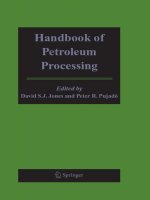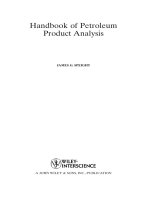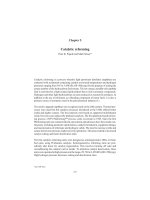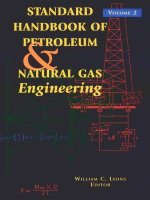Definitions handbook of petroleum product analysis
Bạn đang xem bản rút gọn của tài liệu. Xem và tải ngay bản đầy đủ của tài liệu tại đây (499.21 KB, 5 trang )
Definitions – Handbook of Petroleum Product Analysis
Assignment
Definitions of Important Terms Covered till now (Thursday, May 02, 2013) in class
– Handbook of Petroleum Product Analysis
Chapter # 1: Petroleum Analysis
Sampling
The sample used for test(s) must be representative of the bulk material otherwise the result will
be incorrect no matter how accurate or precise the method is.
Accuracy
It is a measure of closeness of test result to the true value. Absolute accuracy can be measured
only if true value is known.
Precision
The precision of a test method is the variability between test results obtained on the same
material using the specific test method. The precision of a test is usually unrelated to its
accuracy. The results may be precise but not necessarily accurate. In fact, the precision of an
analytical method is the amount of scatter in the results obtained from multiple analyses of a
homogeneous sample. To be meaningful, the precision study must be performed using the exact
sample and standard preparation procedures that will be used in the final method. Precision is
expressed as repeatability and reproducibility.
Method Validation
Method validation is the process of proving that an analytical method is acceptable for its
intended purpose.
Chapter # 2: Petroleum and Petroleum Products
Composition
Elemental analysis of petroleum shows that the major constituents are carbon and hydrogen
with smaller amounts of sulfur (0.1–8% w/w), nitrogen (0.1–1.0% w/w), and oxygen (0.1–3%
w/w), and trace elements such as vanadium, nickel, iron, and copper present at the part per
million (ppm) level.
Petroleum Refinery Engineering – CIIT Lahore
Definitions – Handbook of Petroleum Product Analysis
Petroleum Assay
The testing of petroleum sample to determine its composition and quality is called petroleum
assay.
Carbon Residue
The carbon residues of petroleum and petroleum products serve as an indication of the
propensity of the sample to form carbonaceous deposits (thermal coke) under the
influence of heat – generally applicable to relatively nonvolatile samples that
decompose on distillation at atmospheric pressure.
Asphaltene Content
The asphaltene fraction is the highest molecular weight, most complex fraction in
petroleum. The asphaltene content gives an indication of the amount of coke that can
be expected during processing.
Metallic Constituents
Petroleum, as recovered from the reservoir, contains metallic constituents but also picks
up metallic constituents during recovery, transportation, and storage. Even trace
amounts of these metals can be deleterious to refining processes, especially processes
in which catalysts are used. Trace components, such as metallic constituents, can also
produce adverse effects in refining either (1) by causing corrosion or (2) by affecting the
quality of refined products.
Salt Content
The salt content of crude oil is highly variable and results principally from production
practices used in the field and, to a lesser extent, from its handling aboard the tankers
bringing it to terminals. The bulk of the salt present will be dissolved in coexisting water
and can be removed in desalters, but small amounts of salt may be dissolved in the
crude oil itself. Salt may be derived from reservoir or formation waters or from other
waters used in secondary recovery operations. Aboard tankers, ballast water of varying
salinity may also be a source of salt contamination.
Salt in crude oil may be deleterious in several ways. Even in small concentrations, salts
will accumulate in stills, heaters, and exchangers, leading to fouling that requires
expensive cleanup. More importantly, during flash vaporization of crude oil certain
metallic salts can be hydrolyzed to hydrochloric acid according to the following
reactions:
2NaCl + H2O 2 HCl + Na2O
MgCl2 + H2O 2 HCl + MgO
Petroleum Refinery Engineering – CIIT Lahore
Definitions – Handbook of Petroleum Product Analysis
The hydrochloric acid evolved is extremely corrosive, necessitating the injection of a
basic compound, such as ammonia, into the overhead lines to minimize corrosion
damage. Salts and evolved acids can also contaminate both overhead and residual
products, and certain metallic salts can deactivate catalysts.
Thus knowledge of the content of salt in crude oil is important in deciding whether and
to what extent the crude oil needs desalting.
Sulfur Content
Sulfur is present in petroleum as sulfides, thiophenes, benzothiophenes, and
dibenzothiophenes. In most cases, the presence of sulfur is detrimental to the
processing because sulfur can act as catalytic poisons during processing.
Water and Sediment
Considerable importance is attached to the presence of water or sediment in petroleum
because they lead to difficulties in the refinery, for example, corrosion of equipment,
uneven running on the distillation unit, blockages in heat exchangers, and adverse
effects on product quality. Water and Sediment result from production and
transportation practices.
Wax Content
Petroleum with high wax content presents difficulties in handling and pumping as well
as producing distillate and residual fuels of high pour point and lubricating oils that are
costly to dewax.
The temperature at which the wax first appears is the wax appearance point.
Reid Vapor Pressure Test
Measures the vapor pressure of volatile petroleum
Acid Number
The acid number is the quantity of base, expressed in milligrams of potassium hydroxide
per gram of sample that is required to titrate a sample in this solvent to a green/greenbrown end point using p-naphtholbenzein indicator solution
Aniline Point
Used to estimate the aromatic content of petroleum
Petroleum Refinery Engineering – CIIT Lahore
Definitions – Handbook of Petroleum Product Analysis
Chapter # 3: Gases
Liquefied Petroleum Gas
Liquefied petroleum gas (LPG) is a mixture of the gaseous hydrocarbons propane (CH3CH2CH3,
boiling point: –42°C, –44°F) and butane (CH3CH2CH2CH3, boiling point: 0°C, 32°F) that are
produced during natural gas refining, petroleum stabilization, and petroleum refining.
Refinery Gas
Refinery gas is the non-condensable gas that is obtained during distillation or treatment
(cracking, thermal decomposition) of petroleum. It consists mainly of hydrogen (H2), methane
(CH4), ethane (C2H6), propane (C3H8), butane (C4H10), and olefins (RCH=CHR1, where R and R1
can be hydrogen or a methyl group) and may also include off-gases from petrochemical
processes.
Chapter # 4: Naphtha
Lightest liquid petroleum product that boils from 30oC to 200oC.
Naphtha Production: Naphtha is produced by any one of several methods, which include (1)
fractionation of straight-run, cracked, and reforming distillates or even fractionation of crude
petroleum; (2) solvent extraction; (3) hydrogenation of cracked distillates; (4) polymerization of
unsaturated compounds (olefins) and (5) alkylation processes. In fact, naphtha may be a
combination of product streams from more than one of these processes.
The more common method of naphtha preparation is distillation. Depending on the design of
the distillation unit, either one or two naphtha steams may be produced: (1) a single naphtha
with an end point of about 205∞C (400∞F) and similar to straight-run gasoline or (2) this same
fraction divided into light naphtha and heavy naphtha. The end point of the light naphtha is
varied to suit the subsequent subdivision of the naphtha into narrower boiling fractions and may
be of the order of 120∞C (250∞F).
Aromatic content is a key property of low-boiling distillates such as naphtha and gasoline
because the aromatic constituents influence a variety of properties including boiling range,
viscosity, stability, and compatibility with a variety of solutes.
Evaporation Rate: The evaporation rate is an important property of naphtha, and although there
is a significant relation between distillation range and evaporation rate, the relationship is not
straightforward.
Flash point data are used in shipping and safety regulations to define flammable and
combustible materials. Flash point data can also indicate the possible presence of highly volatile
and flammable constituents in a relatively nonvolatile or nonflammable material.
Petroleum Refinery Engineering – CIIT Lahore
Definitions – Handbook of Petroleum Product Analysis
Kauri-Butanol Value: The kauri-butanol value is the number of milliliters of the solvent, at 15°C
(77°F), required to produce a defined degree of turbidity when added to 20 g of a standard
solution of gum kauri resin in n-butyl alcohol. The kauri-butanol value of naphtha is used to
determine relative solvent power.
For kauri-butanol values of 60 and higher, the standard is toluene, which has an assigned value
of 105, whereas for kauri-butanol values less than 60, the standard is a blend of 75% n-heptane
and 25% toluene, which has an assigned value of 40.The kauri-butanol value of products that are
classified as regular mineral spirits normally varies between 34 and 44; xylene is 93, and
aromatic naphtha falls in the range 55–108.
However, the data obtained by the kauri-butanol test depend on factors other than solvent
power and are specific to the solute used. For this reason, the aniline point is often preferred to
the kauri-butanol number.
Chapter # 5: Aviation Fuel
Acidity
Acidic compounds can also be present in aviation turbine fuels either because of the acid
treatment during the refining process or because of naturally occurring organic acids. Acidity is
an undesirable property because of the possibility of metal corrosion and impairment of water
separation characteristics of the fuel.
Freezing Point
The freezing point of aviation fuel is an index of the lowest temperature of its utility for the
specified applications. Aviation fuels must have acceptable freezing point and low-temperature
pumpability characteristics so that adequate fuel flow to the engine is maintained at high
altitude.
Muhammad
Muhammad Bin Abbas
CIIT/SP10-BEC-025/LHR
Department of Chemical Engineering
CIIT Lahore
Petroleum Refinery Engineering – CIIT Lahore









